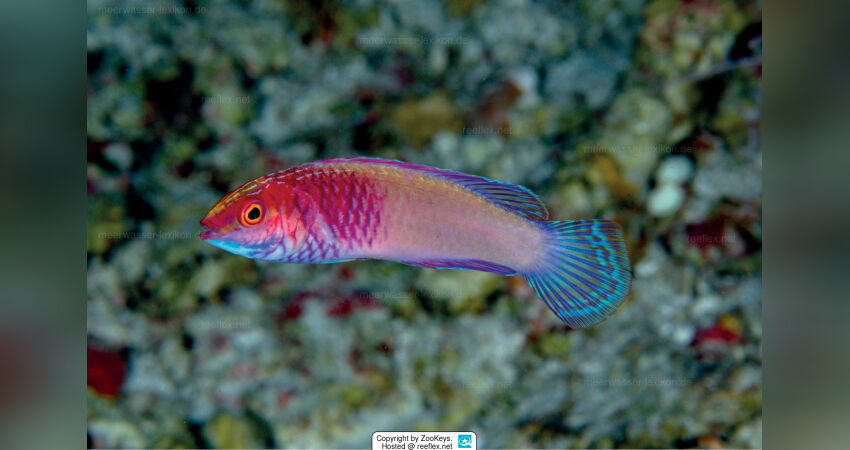Newly described: The rose jewelled wrasse - Cirrhilabrus finifenmaa

Foto: Rasdhoo Atoll, Maldiven / 60 Meter Tiefe / Foto: LAR Mit freundlicher Genehmigung des Urhebers ZooKeys
According to ZooKeys, this fish belongs to the "Cirrhilabrus jordani species complex, a group of deep-sea wrasses found primarily in mesophotic coral ecosystems". This beautiful fish has also already been included in the Seawater Lexicon. Article by Andreas Völckers, Hamburg.
On 8 March 2022, a new fairy wrasse species, a Deep Sea wrasse, published.
Currently, ZooKeys ranks second in the Index of Organism Names among the top 10 journals with the most new publish taxa in zoology.
According to ZooKeys, this fish belongs to the "Cirrhilabrus jordani species complex, a group of deep-sea wrasses found primarily in mesophotic coral ecosystems."
The website also notes that the name is derived from the Dhiveh word 'finifenmaa', alluding to the "vivid colouration of this species".
"The pink rose fiyatoshi finifenmaa (Rosa spp.) is also the national flower of the Maldives.
The Maldives Marine Research Institute noted that it was one of the first species to be named in Dhivehi - the local language of the Maldives.
habitat and distribution
Cirrhilabrus finifenmaa is currently known from the Maldives and Sri Lanka, where it lives at depths of 40-m. It is likely that this species occurs at greater depths.
Like other Cirrhilabrus species, C. finifenmaa often lives on rubble beds with loose coral growth.
Colouration of females and juveniles in life
Described on the basis of colour photographs of the holotype and of live specimens photographed in the field and in aquaria, they resemble males except that the distinction between the magenta head and anterior body from the paler posterior two-thirds is less obvious and sometimes shows through; the colouration of the median fins is less obvious and appears hyaline or pale orange-pink.
juveniles are similar to females except that they are uniformly sheer pink; the median fins are pink and hyaline.
colouring of males in life
The colour description was based on colour photographs of the holotype and paratypes in fresh condition, as well as live specimens photographed in the field and in aquaria.
The head is magenta-red to orange-red, with a red stripe running from the centre of the upper lip to the centre of the upper edge of the eye socket, continuing to the front half of the dorsal fin base.
A second stripe of similar colour runs from the lower edge of the upper jaw to the centre of the lower edge of the eye socket;
Four to five thin white stripes run across the neck to the front of the back;
The preopercles on the outer edge are distinctly purple, the iris bright yellow with a red ring around the pupil.
The front third of the body is magenta-red to orange-red-pink, the remaining two thirds peach to orange-rose.
The scales on the operculum, the breast, the isthmus and the anterior third of the body with a dark purple central area, the pattern appearing cross-hatched.
The dorsal fin orange, sometimes pink, becoming increasingly hyaline in the posterior part.
The outer edge of the dorsal fin is metallic blue, the segmented dorsal fin rays deep purple.
Two-thirds of the tail fin is magenta to pinkish red, the remaining third metallic blue;
The caudal fin rays are deep purple, the anal fin similar to the dorsal fin.
The pelvic fins are translucent orange, the fin rays are deep purple.
Very similar styles:
Cirrhilabrus rubrisquamis Randall & Emery, 1983 and
Cirrhilabrus wakanda Tea, Pinheiro, Shepherd & Rocha, 2019
Although the species has just received its name, it is already being exported for trade.
en.sun.mv
literature-findings:
Tea Y-K, Najeeb A, Rowlett J, Rocha LA (2022)
Cirrhilabrus finifenmaa (Teleostei, Labridae), a new species of fairy wrasse from the Maldives, with comments on the taxonomic identity of C. rubrisquamis and C. wakanda. ZooKeys 1088: 65-80. doi.org
How do you like this article?
Info
Author

Bookmark
Comments
Topics
Similar articles
- Neue Verpackungsgröße Meersalz - Neue Verpackungsgröße Aiptasia-X
- News: The Smart ATO Lifter from AUTO AQUA
- Deutsche Zoofachleute auf Sri Lanka – verbesserten Importchancen auf der Spur
- Die BOLUS Methode - by Fauna Marin
- Introducing the ArtReef Rock Creations
- Pictures and Stories from Marine Aquaristics Volume 2
- Sealife Speyer sucht 1 Aquarist, Tierpfleger und Techniker
- The new way to design an aquarium - CoraroC!
- Delta Corals - THE SEA WATER AQUARISTICS SHOP IN NEW-ULM
- The online shop around the jellyfish world
Comments To the top
Please register
In order to be able to write something yourself, you must register in advance.






